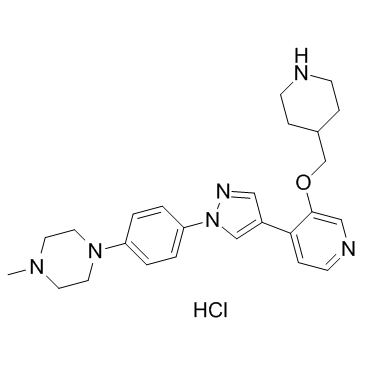MELK-8a hydrochloride (Synonyms: NVS-MELK8a) |
| カタログ番号GC32736 |
MELK-8a 塩酸塩は、IC50 が 2 nM の新規母体胚性ロイシンジッパーキナーゼ (MELK) 阻害剤です。
Products are for research use only. Not for human use. We do not sell to patients.

Cas No.: 2096992-20-8
Sample solution is provided at 25 µL, 10mM.
MELK-8a hydrochloride is a novel maternal embryonic leucine zipper kinase (MELK) inhibitor with an IC50 of 2 nM.
MELK-8a remains very potent (IC50=140 nM) when the ATP concentration in the biochemical assay is shifted from 20 μM to 2 mM. Its potency is well tracked between full-length MELK versus catalytic domain construct (5 nM versus 2 nM). It only inhibits seven off-target kinases in addition to MELK with >85% inhibition of binding at 1 μM demonstrating great selectivity. The compound is at least 90-fold more selective in targeting MELK in all cases. MELK-8a is fairly soluble (0.22 g/L at pH 6.8) and shows a good permeability in the Caco-2 assay. MELK-8a inhibits the growth of MDA-MB-468 cells and MCF-7 cells with an IC50 of approximately 0.06 and 1.2 μM, respectively[1].
Subcutaneous administration of MELK-8a at 30 mg/kg in C57BL/6 mice results in good plasma exposure. The compound adsorption into the systemic circulation is rapid (Tmax=0.4 h) and peak plasma concentration reaches 6.6 μM. An ascending dose PK study in female athymic nude mice shows that the rate of compound release is maximal at 120 mg/kg and all clearance mechanisms can be saturated at 240 mg/kg. However, when administered orally at 10 mg/kg in C57BL/6 male mice, it shows very poor PK (3.6% oral bioavailability) consistent with very high in vivo clearance[1].
[1]. Touré BB, et al. Toward the Validation of Maternal Embryonic Leucine Zipper Kinase: Discovery, Optimization of Highly Potent and Selective Inhibitors, and Preliminary Biology Insight. J Med Chem. 2016 May 26;59(10):4711-23.
Average Rating: 5 (Based on Reviews and 33 reference(s) in Google Scholar.)
GLPBIO products are for RESEARCH USE ONLY. Please make sure your review or question is research based.
Required fields are marked with *




















